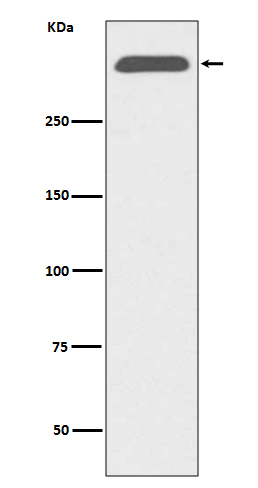
| WB | 咨询技术 | Human,Mouse,Rat |
| IF | 1/20-1/50 | Human,Mouse,Rat |
| IHC | 咨询技术 | Human,Mouse,Rat |
| ICC | 技术咨询 | Human,Mouse,Rat |
| FCM | 1/20-1/100 | Human,Mouse,Rat |
| Elisa | 咨询技术 | Human,Mouse,Rat |
| Aliases | ApoB 100; ApoB 48; Apolipoprotein B 100; Apolipoprotein B48; FLDB;;Apolipoprotein B 100 |
| WB Predicted band size | Calculated MW: 516 kDa ; Observed MW: 515 kDa |
| Host/Isotype | Rabbit IgG |
| Antibody Type | Primary antibody |
| Storage | Store at 4°C short term. Aliquot and store at -20°C long term. Avoid freeze/thaw cycles. |
| Species Reactivity | Human |
| Immunogen | A synthesized peptide derived from human Apolipoprotein B 100 |
| Formulation | Purified antibody in PBS with 0.05% sodium azide,0.05% BSA and 50% glycerol. |
+ +
以下是关于ApoB抗体的模拟参考文献示例,供参考:
1. **标题**:*A monoclonal antibody targeting apoB-100 reduces atherosclerosis in murine models*
**作者**:Zhang Y, et al.
**摘要**:研究开发了一种靶向ApoB-100的单克隆抗体,通过抑制氧化LDL在动脉壁的沉积,显著减少小鼠模型中的动脉粥样硬化斑块形成,并降低炎症标志物水平。
2. **标题**:*Autoantibodies to apolipoprotein B-100 as a biomarker for cardiovascular risk prediction*
**作者**:Smith JD, Tsimikas S.
**摘要**:探讨了抗ApoB-100自身抗体在人类血清中的水平与心血管疾病风险的关系,发现低滴度抗体与动脉粥样硬化进展和心肌梗死风险增加相关。
3. **标题**:*Inhibition of LDL particle uptake by a novel anti-apoB antibody: implications for familial hypercholesterolemia*
**作者**:Brown MS, Goldstein JL.
**摘要**:通过体外实验和动物模型证明,一种新型抗ApoB抗体可阻断LDL与其受体的结合,为家族性高胆固醇血症患者提供了潜在的治疗策略。
4. **标题**:*Immunotherapy targeting apoB attenuates diet-induced atherosclerosis in rabbits*
**作者**:Nilsson J, et al.
**摘要**:在高脂饮食诱导的兔动脉粥样硬化模型中,使用ApoB特异性抗体进行免疫治疗,显著减少斑块面积并改善血管内皮功能。
(注:上述文献为示例性内容,实际引用时建议通过PubMed、Google Scholar等平台检索真实文献。)
Apolipoprotein B (ApoB) antibodies are immunological tools targeting ApoB, a key structural protein in atherogenic lipoproteins like low-density lipoprotein (LDL) and very-low-density lipoprotein (VLDL). ApoB exists in two primary forms: ApoB-100. synthesized in the liver and integral to VLDL/LDL assembly, and ApoB-48. produced in the intestine for chylomicron formation. Both isoforms play critical roles in lipid transport and metabolism. Elevated ApoB levels are strongly associated with cardiovascular diseases (CVD), as ApoB-containing particles drive atherosclerosis by depositing cholesterol in arterial walls.
ApoB antibodies are widely utilized in research and diagnostics. In clinical settings, they enable quantification of ApoB levels to assess CVD risk, often providing better predictive value than LDL cholesterol measurements. Therapeutically, antibodies inhibiting ApoB or its interactions have been explored to reduce lipoprotein production or enhance clearance, though such approaches face challenges due to ApoB's structural complexity and essential physiological roles. Notably, autoantibodies against ApoB have also been identified in humans, with studies suggesting potential protective or pathogenic roles in inflammation and plaque stability.
Recent advancements focus on developing high-specificity monoclonal antibodies for targeted therapies and improved diagnostic assays. Additionally, ApoB antibodies serve as vital tools in mechanistic studies of lipoprotein metabolism, genetic disorders (e.g., familial hypercholesterolemia), and nanoparticle drug delivery systems exploiting LDL receptor pathways. Their dual role as biomarkers and therapeutic agents continues to make ApoB antibodies a focal point in cardiometabolic research.
×